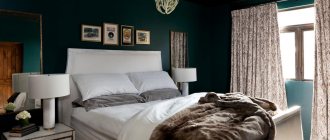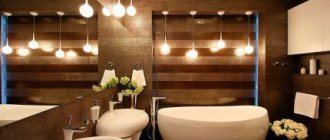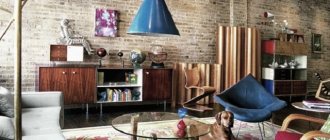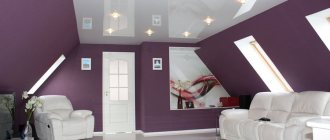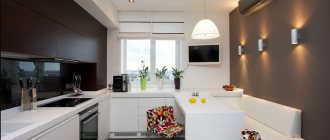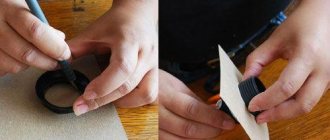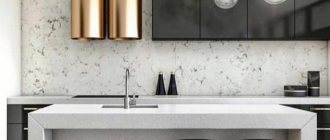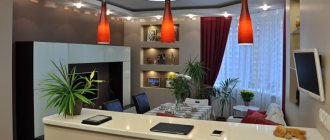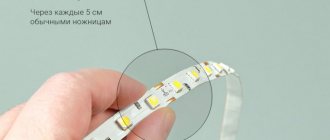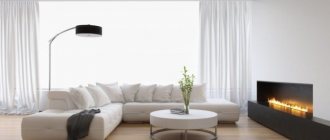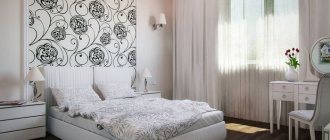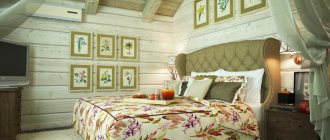What types are there?
According to the type of lamps, track lamps are:
Halogen
Improved incandescent lamps with added buffer gas. Thanks to the modifications, they shine brighter and work longer. They are considered one of the most inexpensive.
Luminescent
Bright, economical. Typically used for accent lighting.
LED
Diodes are the most modern tracking solution. They shine brightly and evenly, last a long time, and are economical in electricity consumption.
By number of phases:
Single-phase
All lamps are controlled by one button, there is no possibility of setting scenarios.
Two-, three-phase
The lamps are divided into 2-3 groups, controlled from different switch buttons. Turned on separately.
Cafe lighting
Track systems are ideal for lighting cafes , restaurants and bars. To get the best result, it is important to first develop a design project and make a lighting calculation that will help take into account the peculiarities of the room layout and other nuances.
What you need to pay special attention to when developing a project:
- The guest room must have basic and accent lighting.
- A rational solution would be to purchase dimmable LED lamps with the ability to change not only the brightness of the light, but also its color temperature. This approach will allow you to adjust the lighting in the hall to the time of day, certain events and holidays.
- When choosing spots to illuminate a bar counter, it is best to give preference to Downlights models, in which the light beam is directed straight down. This will allow the bartender’s work area to be well illuminated and prevent glare on glass surfaces.
What to consider when choosing?
When choosing track lighting for your interior, pay attention to the following characteristics:
type of instalation
First of all, decide on what basis and how you are going to install the structure - the choice of the main element - the profile - depends on this. There are suspended, overhead and built-in.
Element material
Lightweight and durable aluminum is an excellent choice for both tires and lampshades.
Control options
In the previous section, we have already discussed busbar trunking options based on the number of phases: one phase is usually sufficient in unidirectional rooms, such as a hallway or a bathroom. Two or three are already needed in bedrooms, living rooms, kitchens, offices, and children's rooms.
Thanks to the settings, you can install a single system, for example, above the work area and the dining table, but turn the elements on and off separately from each other.
The photo shows a black bus lamp in the loft style
Type, lamp power
Using modern diode light bulbs, you simultaneously save on electricity and provide yourself with even, bright lighting without flickering or glare. Although LEDs are more expensive than halogen ones, they last longer: on average 7-9 years.
To correctly determine the required power, you should calculate the required figure based on the area of the room: for example, a living room requires bright light of ~3 W (LED!) per 1 square meter. Accordingly, a living room of 20 m2 will need lamps with a total power of 60 W. This can be 10 pieces of 6 W or 6 brighter ones of 10 W.
Additional features
In bathrooms and toilets, be sure to choose components with protection of at least IP44 - otherwise high humidity can lead to a short circuit in the wiring. The second example is line voltage: do you need 220, 380 or 12 volts?
Design
The decorative component includes stylization, color, and shape of the lampshades. For example, minimalistic and futuristic models are suitable for high-tech style. In a classic interior, flexible ceiling lamps will look better. For the loft style, there are generally track lamps in the form of pendants.
As for the shade, choose it to suit your interior. Standard color variations include white, black, chrome. Bronze, copper, platinum, and gilding are less common. Even rarer are color designer sets.
The last difference is the shape of the case. A cylinder or cone is considered universal. Fashionable original ones resemble small spotlights, suitable as an idea for modern interiors. There are also balls, squares, flat circles, and elongated oblong lamps.
Photos of track lamps
Read here! Lamps for the home - selection for a modern interior, features of lighting calculations and installation of a lighting system (135 photos)
What's the best way to position it?
The placement of track lights in a room depends on 2 components: the shape of the room and its functionality. This leads to 3 main layouts:
Look at examples of the arrangement of lamps on a suspended ceiling.
Line
Used in three cases.
- First: when track lights are an integral part of the overall lighting concept. In this situation, they highlight one of the zones: for example, a desktop, a kitchen countertop, a closet.
- Second: the tire is located in a narrow, elongated space. For example, the corridor. Then directed bright light along the center is more than enough.
- The third is a wide room where light lines are installed parallel to each other. The number of lines is not limited. Usually 2-5.
Corner
When there are not enough lines, but you don’t want to occupy the entire ceiling area with a track. Often used in corner kitchens, above corner sofas, in L-shaped layouts.
Square, rectangle
A “closed” figure outlines the outline of the room: this is important when all the lighting is based on track lighting. The lamps are placed along the contour, pointing in different directions - somewhere to illuminate a picture on the wall, somewhere on a table.
Sometimes it is also used in conjunction with a chandelier in the center or for zoning a room in an open plan. For example, a square of tracks highlights the living room area.
The photo shows contour lighting in the living room
The last nuance concerns not the form, but the format: most often, track lamps are installed in an overhead manner. That is, the tire and lamps remain visible. But in some cases it is appropriate to resort to camouflage techniques by hiding the track in a niche or securing it between beams in a slatted ceiling, for example.
Installation of track lighting systems
How to hang a track light?
To implement a track system, you need to draw up a project in which you should indicate the path of the track, the number, power and location of lamps, as well as the height of their suspension above the floor level. Based on the project, you can calculate the length of the track, the total electrical power, and the number of components required to purchase the kit. It is especially worth considering where to connect the power wire. Installation is not very difficult and can be done by a non-professional.
Attaching busbar guides to the ceiling
This task is performed using dowels with self-tapping screws every 800 mm (in the absence of other instructions from the manufacturer). There are also options for hanging the entire busbar on cables (for high loft ceilings). If the dowel scheme is clearly unreliable (heavy loads), it is necessary to use anchor fastening.
Installation of track lights on the busbar
Lamps installed on the track must belong to its structural system, otherwise the connection may not take place. Each lamp is equipped with an adapter - a connection device with a lock. When connecting to the track, the lock handle is turned, this ensures mechanical fastening and electrical contact. If it is necessary to change the position on the track, the lock is turned off and turned on again at another point.
The types of track lights produced by industry vary in design. The larger part has a rotating head connected to the adapter by a short leg. There are lamps on a long cable or rod. The simplest products are those in which the adapter and lamp are combined, and there is no rotation.
Track lamps are the most modern type of lighting for both public and private areas that can solve any problem. In order for the system to serve for a long time and without failures, choose to purchase components from companies that inspire the most confidence in you.
